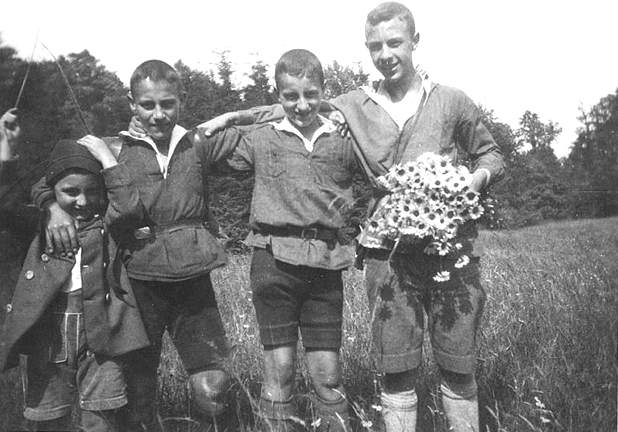
Belts: Fashion Accesory

Figure 1.--Here we see German boys wearing belts over their jacket-like tunics. We are not sure just why they did this, but it had to be for the look as because the belts played no practical purposes. The snapshot is undated, but we woild guess was taken about 1930.
|
|
Belts are not only practical items, they also can be used to decorative affect. This has varied over time an among countries. We note belts being worn as a fashion accessory with a variety of garments. We notice boys wearing belts over their jackets and sweaters where they had no practical use. This appears to have been a military influence. We notice belts being worn over dresses and tunics as well. A good example is Edward Edwards in the 1840s. We also note an unidentified American boy wearing what looks like a leather belt over a dress, we think in the 1850s. Another early example here is an unidentified American boy wearing a belt over his tunic, we think in the 1840s. The belts worn over tunics could be styilized. Another example is a German boy about 1880. We have noted this into the 1930s. We note large numbers of European boys, especially German boys wearing belts over their sweaters. This continued into thee 1950s, but less commonly. We also notice mock-belts being worn a part of various garments. The most common here was the tunic. The belt was a very common feature of tunic styling. This belted look was also incorporated into the Norfolk jacket.
Fashion Accessory
Belts were practical items, primarily designed to hold up trousers. We see many photographs, however, showing belts as a fashion accessory for no real practical purpose. We are not sure just why they did this, but it had to be for the look as because the belts played no practical purposes. This appears to have been a military influence which may be why boys liked the look.
We notice two types of these decorative belts. The first is obvious, belts worn over garments (tunics, jackets, and sweaters). These are generally plain belts. It is the wearing of the belt that is a fashion statement. They were mostly made of leather as one might expect from a belt with was basically a military style. We also notice belts that at first glace appear to be holding up the boys' trousers. But on closer examination the pants do not have any belt loops. So the belts do not seem to be a decorative item rather than a trouser support item as we first assumed. There seems to have been some other way of holding up the trousers. Some of these belts are very wide and highly decorative. They are made of various materials, including cloth. This seems to be primary a central or eastern European styles.
Chronology
waring belts as a fashion accessory rather than for the practical purpose of holding up pants has varied over time. We are not sure when this began, but we notice it in paintings and very early photographic porraits. We cfirst see boys wearing belts as a fashion accesspry rather than for the practical purpose os suspending trousers. Boys wear belts over tunics for whuchb thaere was no real practical mpurpose. A good example is Edward Edwards in the 1840s, perhaps for school. We notice an Englisg boy in an ideaized Victorian family wearing a black belt over a maroon tunic during the early-1850s.
Garments
We note belts being worn as a fashion accessory with a variety of garments. We notice boys wearing belts over their jackets and sweaters where they had no practical use. We notice belts being worn over dresses and tunics as well. We also note an unidentified American boy wearing what looks like a leather belt over a dress, we think in the 1850s. Another early example here is an unidentified American boy wearing a belt over his tunic, we think in the 1840s. The belts worn over tunics could be styilized. Another example is a German boy about 1880. We have noted this into the 1930s. We note large numbers of European boys, especially German boys wearing belts over their sweaters. This continued into thee 1950s, but less commonly. We also notice mock-belts being worn a part of various garments. The most common here was the tunic. The belt was a very common feature of tunic styling. This belted look was also incorporated into the Norfolk jacket.
Country Trends
The popularity of this belt fashion varied from country to country. Boys from many different countries wore belts as a fashion accessory for purelu ornamental purposes. It was very common with tunics. Wearing belts over sweaters was not as wide spread. We note quite a few German boys doing this. It was not onlu German boys, but the fashion seems to have been particularly popular in Germany. We note an unidentified German boy.
We also note Swiss boys, especially German speakers. An example is an unidentified Swiss boy, Another example is another unidentified Swiss boy.
HBC

Navigate the Boys' Historical Clothing Web Site:
[Return to the Main belt page]
[Return to the Main trouser suspension type page]
[Return to the Main trouser page]
[Introduction]
[Activities]
[Biographies]
[Chronology]
[Clothing styles]
[Countries]
[Bibliographies]
[Contributions]
[FAQs]
[Glossaries]
[Images]
[Images]
[Links]
[Registration]
[Tools]
[Boys' Clothing Home]
Created: 12:43 AM 3/20/2009
Last updated: 9:45 PM 5/14/2009



